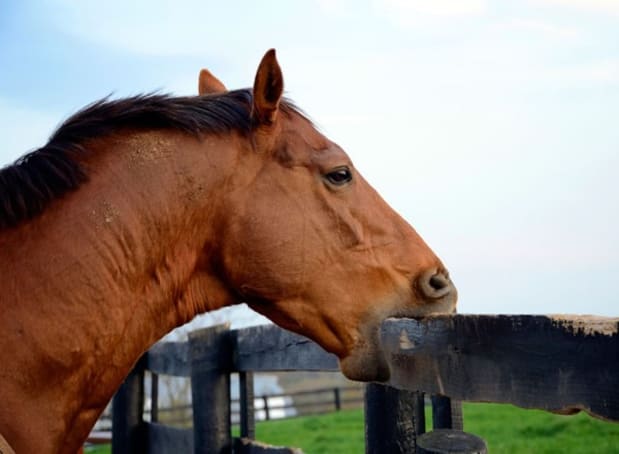 Cribbing is a self-stimulatory behavior in horses characterized by the horse grabbing an object with its upper teeth and pulling against it, arching its neck. Some possible causes are stress, boredom, temperament, and diet and there may be a genetic disposition. Thoroughbreds are the number-one breed for cribbing, with 8% of them exhibiting the behavior. Quarter Horses are next most likely. Evidence points to a genetic link for cribbing. It is a myth that it is learned from other horses.
Cribbing is a self-stimulatory behavior in horses characterized by the horse grabbing an object with its upper teeth and pulling against it, arching its neck. Some possible causes are stress, boredom, temperament, and diet and there may be a genetic disposition. Thoroughbreds are the number-one breed for cribbing, with 8% of them exhibiting the behavior. Quarter Horses are next most likely. Evidence points to a genetic link for cribbing. It is a myth that it is learned from other horses.
Cribbing appears to start primarily in younger horses, generally around 20 weeks of age. You can lower the risk of cribbing by making sure young horses have a lot of social contact with other horses and spend as much time as possible at pasture.
There is no sure remedy for cribbing. However, there may be ways to manage it in some horses, with varying degrees of success.
• A cribbing strap (collar) – prevents the horse from flexing her neck muscles when pulling back on an object. Uncomfortable for the horse, but doesn’t harm her.
• Cribbing Muzzles – Allow the horse to eat and drink but she can’t get her mouth around a solid object to crib.
• Increased outdoor activity, socialization, and some toys may help.
• Eliminating cribbing surfaces where feasible, reducing the opportunity to engage in the behavior.
• Eliminating or greatly decreasing sweet feed may help. Feeding straight oats appears to decrease the frequency (for horses fed grain in lieu of forage).
• There is some evidence that antacids may help some horses. (Please consult your veterinarian for more information – do not introduce antacids to your horse’s regimen without discussing with a veterinarian first.)
The longer a horse has been cribbing, the harder the behavior is to stop. Until there’s a cure, diligent management is key. And cribbing horses are often otherwise functional. They can still be great trail and performance horses and pasture pets.
Posted: April 27, 2021 by Connie Morris
Cribbing (aerophagia, crib biting)
Cribbing appears to start primarily in younger horses, generally around 20 weeks of age. You can lower the risk of cribbing by making sure young horses have a lot of social contact with other horses and spend as much time as possible at pasture.
There is no sure remedy for cribbing. However, there may be ways to manage it in some horses, with varying degrees of success.
• A cribbing strap (collar) – prevents the horse from flexing her neck muscles when pulling back on an object. Uncomfortable for the horse, but doesn’t harm her.
• Cribbing Muzzles – Allow the horse to eat and drink but she can’t get her mouth around a solid object to crib.
• Increased outdoor activity, socialization, and some toys may help.
• Eliminating cribbing surfaces where feasible, reducing the opportunity to engage in the behavior.
• Eliminating or greatly decreasing sweet feed may help. Feeding straight oats appears to decrease the frequency (for horses fed grain in lieu of forage).
• There is some evidence that antacids may help some horses. (Please consult your veterinarian for more information – do not introduce antacids to your horse’s regimen without discussing with a veterinarian first.)
The longer a horse has been cribbing, the harder the behavior is to stop. Until there’s a cure, diligent management is key. And cribbing horses are often otherwise functional. They can still be great trail and performance horses and pasture pets.
Category: Misc
PayPal Giving Fund
Network For Good
Silent Donor
Support Us Anonymously! Silent Donor is the largest anonymous donation platform in the world, allowing all donors to send fully anonymous, tax-deductible donations to the causes they want to support. Click the link below to access their private platform – simply write in Faith N Friends as the organization to receive your anonymous donation on their form. Choose to donate via card, bank transfer, stock, or cryptocurrency. Keep the impact of your gift, and also keep your privacy. Send your anonymous donation to support our mission today! Donate Now – Silent Donor
Doris Day Animal Foundation
Follow Us on Social Media